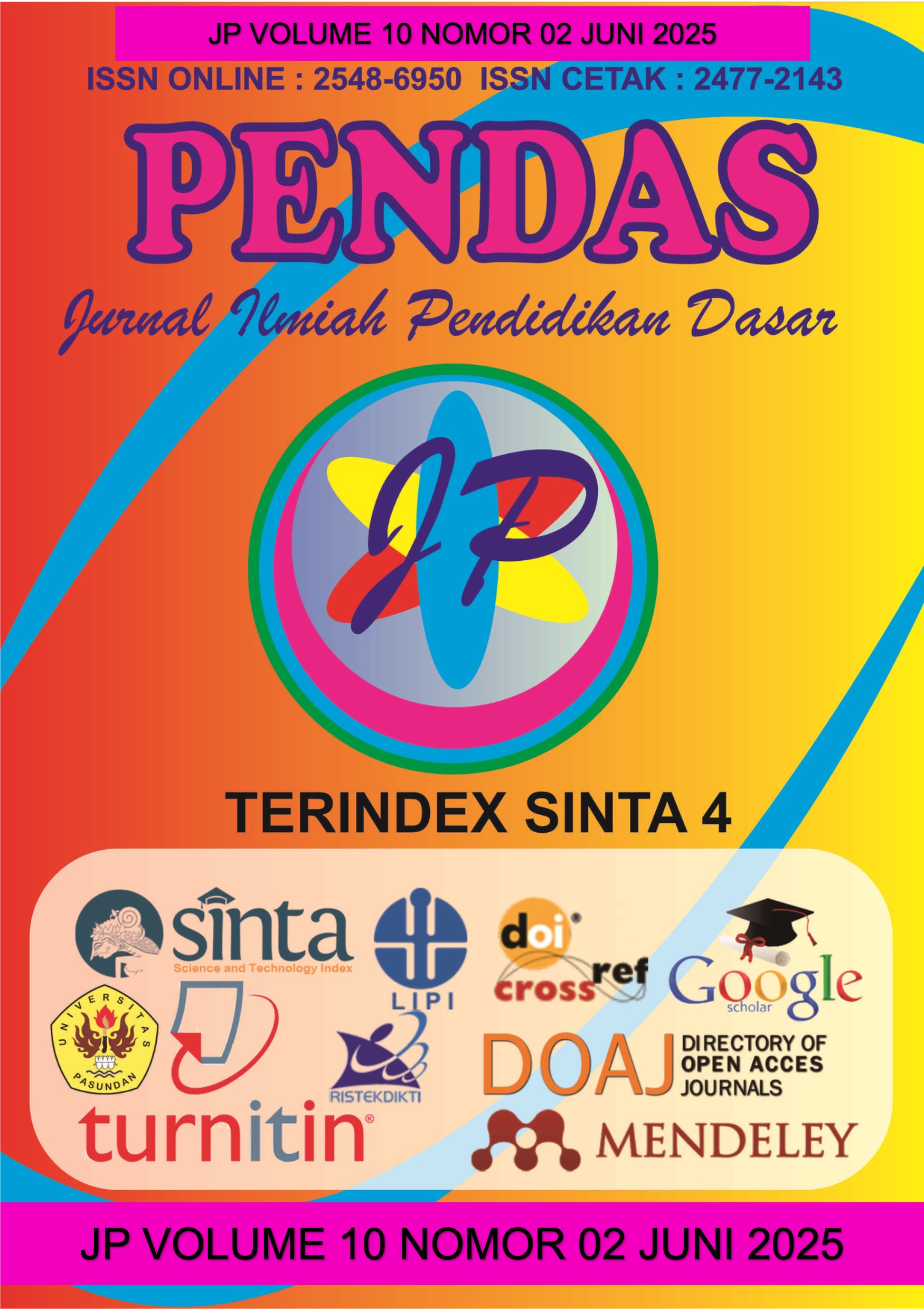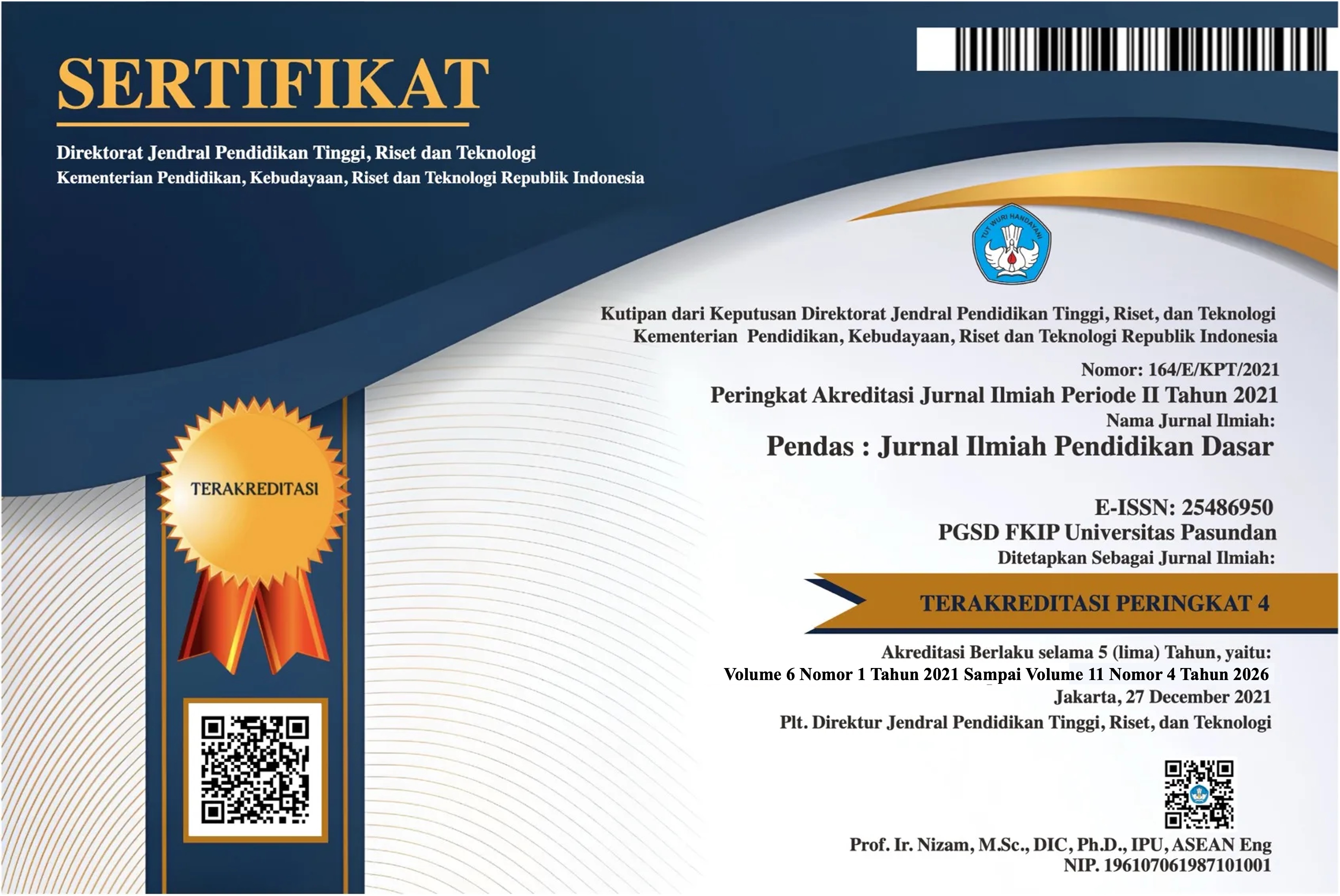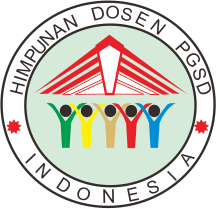THE EFFECT OF VISUAL SCAFFOLDING STRATEGY TOWARDS STUDENTS’ VOCABULARY MASTERY AT THE FIFTH GRADE OF SDN 087981 SIBOLGA
DOI:
https://doi.org/10.23969/jp.v10i2.25353Keywords:
Visual Scaffolding Strategy, Vocabulary MasteryAbstract
This study investigated the impact of Visual Scaffolding Strategy on vocabulary mastery among fifth grade students at SDN 087981 Sibolga. Utilizing a pre-experimental design, the study involved 21 students who participated in six sessions, including a pre-test, four treatment sessions, and a post-test. The findings revealed a significant improvement in vocabulary scores, with the mean score increasing from 54.76 on the pre-test to 85.75 on the post-test, resulting in an increase of 30.99. Statistical analysis confirmed that the t-test value (32.1) exceeded the critical t-table value (8.40), indicating that Visual Scaffolding Strategy effectively improved vocabulary mastery in this educational context. Consequently, the null hypothesis was rejected, confirming the positive effect of the strategy on students' learning outcomes.
Downloads
References
Arikunto, S., 2006. Prosedur Penelitian: Suatu Pendekatan Praktik, Jakarta: Rineka.
Arikunto, S., 2018. Dasar-Dasar Evaluasi Pendidikan Edisi 3. Jakarta: Bumi aksara.
Barreiro, J.A. and Wiyanah, S., 2022. “Improving English Vocabulary Using Visual Mnemonic Technique”. JEdu: Journal of English Education, 2(3):187-195.
Carneiro, R.M.O., McCarten, J., 2007. Teaching Vocabulary: Lessons From the Corpus, Lessons for the Classroom. Cambridge: University Press. New York.
Dewi, M.P., Seprisa, D, Reflinda, Safitri, W. 2022. The Correlation Between Students Vocabulary and Speaking Ability at Seventh Grade in SMPN 2 Dua Koto Kabupaten Pasaman. Educational Management and Strategy Journal, 01, 22.
Fatmawati, A.Y., Miranty, D. and Hamer, W., 2023. “The Effectiveness of Pictionary Games as a Tool to Teach Vocabulary for Senior High School Students”. Edukasi: Jurnal Pendidikan dan Pengajaran, 10(1):103-115.
Fitrianingsih, R. and Musdalifah, M., 2015. “Efektivitas Penggunaan Media Video Pada Pembelajaran Pembuatan Strapless Siswa Kelas XII SMK Negeri 1 Jambu”. Fashion and Fashion Education Journal, 4(1).
Hamer, W. and Lely, L.N., 2019. “Using Pictionary Game to Increase Learners’ Vocabulary Mastery in English Language Instruction”. Journal of English Education Studies, 2(1):43-51.
Herrell AL, Jordan ML., 2015. 50 Strategies for Teaching English Language Learners. California State University: Pearson Education.
Sakti, G., Hutauruk, D.R., Syahrul., Syafitri. W.,2023. The Effect of Using Vocabulary Self-Collection Strategy (VSS) on Student’s Vocabulary Mastery. ELP (Journal of English Language Pedagogy), 8(1), pp.77-87.
Huyen, N.T.T. and Nga, K.T.T., 2003. “Learning Vocabulary Through Games”. Asian EFL journal, 5(4):90-105.
Irwandi, I., Quaidy, G.M. and Albert, A., 2018. “Teaching Vocabulary in Contextualization for Young Learners”. Proceedings of ISELT FBS Universitas Negeri Padang, 6:41-44.
Jeremy, H., 2007. The Practice of English Language Teaching (4th edition). Harlow:Longman. Pearson Education.
Komachali, M.E. and Khodareza, M., 2012. “The Effect of Using Vocabulary Flash Card on Iranian Pre-University Students' Vocabulary Knowledge”. International Education Studies, 5(3):134-147.
L.R.Gay, 1981. Education Research: Competencies for Analysis and Application. (Second edition). Columbus: A Bell & Howell Company.
Lessard-Clouston, M., 2013. Teaching Vocabulary. TESOL International Association: Alexandria.
Madsen, H.S., 1983. Techniques in Testing. Oxford University Press: Madison Ave.
Melani, M., Fitri, Y, Roza, V. and Reflinda, R., 2023. The effect of using Duolingo application toward students’ vocabulary mastery at the second grade of SMPN 1 Koto Besar. Innovative: Journal Of Social Science Research, 3(2), pp.8265-8279.
Munir, S., 2023. “The Effect of Teacher Scaffolding and Peer-Scaffolding on Reading Comprehension and Vocabulary Ability”. JPI (Jurnal Pendidikan Indonesia), 12(3): 451-460.
Nation, I.S. and Nation, I.S.P., 2001. Learning Vocabulary in Another Language. New York Cambridge: University Press.
Nation, I.S., 2005. “Teaching Vocabulary”. New Zealand: Asian ESL/EFL Journal.
Pan, Q. and Xu, R., 2011. “Vocabulary Teaching in English Language Teaching”. Theory & Practice in Language Studies (TPLS) Journal, 1(11). https://doi.org/10,4304/tpls.1.11.1586-1589.
Shoffan Shoffa, 2023. Media Pembelajaran. Jakarta: CV.Afasa Pustaka.
Sugiono., 2016. Metode Penelitian Kunatitatif Kualitatif dan R&D. (Bandung: Alfabeta).
Sumadi Suryabrata, 2014. Metodologi Penelitian, (Jakarta: PT. Raja Grafindo Persada).
Syafitri, W., Yelvia, E., Kardena, A., Dewi, P.M., 2023. The Effect Of Using Pictionary Games On Students’vocabulary Mastery. ELP (Journal of English Language Pedagogy), 8(1), pp.56-65.
Syarifudin, A., Marbun, R. and Novita, D., 2014. “An Analysis on The Students’ Vocabulary Mastery a Descriptive Study On The Mts”. Jurnal Pendidikan dan Pembelajaran Khatulistiwa (JPPK), 3(9).
Thornbury, S., 2002. How To Teach Vocabulary. (England: Person Education Limited).
Wahid, K., Halim, A. and Syukri, S., 2024. “Students’ Response to Visual Scaffolding Activity in the EFL Classroom”. Al Lughawiyaat, Journal Education. 4(1).
Yousda, I.I.A. and Arifin, Z., 1993. Penelitian dan Statistik Pendidikan. Jakarta: Bumi Aksara.
Downloads
Published
Issue
Section
License
Copyright (c) 2025 Pendas : Jurnal Ilmiah Pendidikan Dasar

This work is licensed under a Creative Commons Attribution 4.0 International License.



















